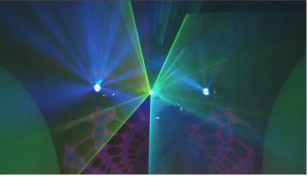About Lasers
Sound
Lasers
Video.
Tech Tips
Laser History
Light Amplification by Stimulated Emission of Radiation.
The first laser was a ruby laser using a ruby rod. Next came the gas laser, the simple red helium neon laser being an example. These first lasers required high voltages and high current and thus consumed a lot of power so got very hot.
 We had an argon ion laser that gave out 30 mW and it required a 3KW power supply. Higher powered lasers needed water cooling.
We had an argon ion laser that gave out 30 mW and it required a 3KW power supply. Higher powered lasers needed water cooling.
Once again, semiconductor technology came to our help when scientists invented the diode laser. This enabled high power lasers to be built that can now fit in your hand. Visible light laser diodes required that a specific type of crystal be pumped by a higher power and lower frequency infrared diode. This enabled small high powered red and green lasers to enter the nightclubs. Pumped blue lasers then came in and enabled us to build our first full colour laser projector with a total light power output of 700mW, and a power supply of only 200 watts. This old gas laser would need a power supply of over 60 KW for the same light power.
Safety
Although smaller, these lasers are more powerful and can cause eye damage. Our 35mW laser could not be officially used to scan the audience and needed a full time operator when in use. However, most laser displays do scan the audience, but smoke must be used and the laser must be continually scanning so that the laser beam cannot remain on the retina for long enough to cause damage. If you stare directly into the beam of a club laser you will damage your eyesight. The more powerful the beam and the more amount of time the laser beam is on your retina, the greater the chance of eye damage. However this type of blindness is not apparent to the person with the damaged eye, due to the tendency of the brain to ignore blind spots. The nightclub is safe from being sued because you do not notice any damage. A retinal scan will show the damage, (but you do not get that at specsavers!). You might get involved in more traffic accidents.
So, dont stare into club lasers. They're a lot more dangerous than than people think.
You have been warned. A 500mW laser could light a cigarette at 40 ft, most lasers in big clubs are between 500 mW and 2 watt.
